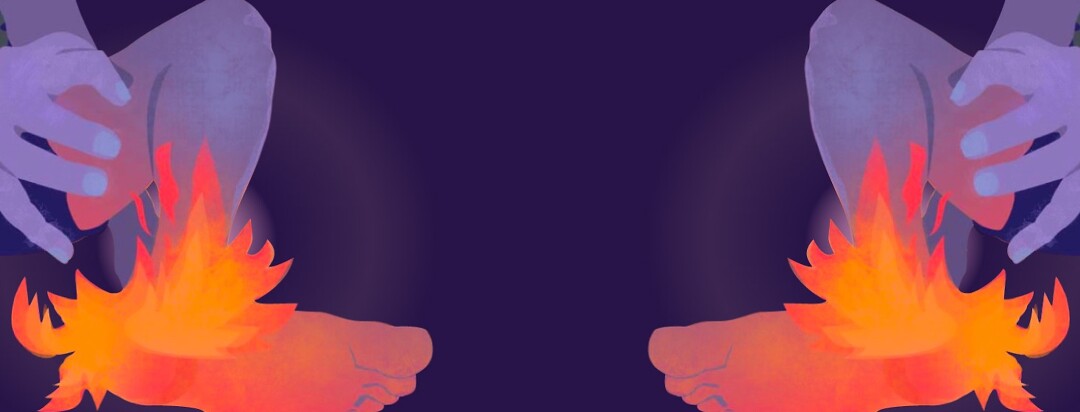What the Heel is Going On?
What started as a small blister on my Achilles heel ended up being anything but. This is my story of how extreme pain, a very swollen joint, and red and purple inflamed skin finally sent me to the clinic, and my advice to not wait it out.
These boots were made for walking
Well, not exactly. Mine was new, and like new shoes, new boots can give you blisters.
As a patient with psoriatic arthritis, my biggest concern is always making sure I don’t overdo and travel too far out on the trail without a feasible way to get back if hip and knee pain proves too much for me to handle. But on this particular Saturday, it wasn’t my disease-causing trouble, it was a nagging blister that formed on my left Achilles heel. It was more annoying than painful.
Bandage on and good to go
I tended to my blister when I got home. I threw on a bandage to keep it from getting infected. It was actually quite small, and I wasn’t concerned at all. On Sunday, I even went to my kickboxing class and had no trouble. The blister hadn’t shrunk, but I had no pain. Again, no concerns, but just to be safe, I kept it bandaged.
On Monday, I woke up with pain, not severe, but enough for me to take notice. It felt like joint pain, not superficial skin pain. I looked at my blister, and it was now triple the size. The surrounding skin was also red. At this time, I put on antibiotic ointment and another bandage.
I was able to monitor it throughout the day and stay off my foot as much as possible. However, by late afternoon, the pain was quite intense, and my ankle was very swollen. Along with my red skin, surrounding areas were turning purple.
If the problem can’t be seen, it is often dismissed.
On the following days, my ankle remained swollen, red, and purple. In the morning, I had minimal pain, but by evening, it was severe. Tears and lots of four-letter words. So, why did I not go to the doctor? Why didn’t I get this problem checked out?
As someone who has dealt with doctors for more than half of her adult life, I’m used to not always being taken seriously. If the problem can’t be seen, it is often dismissed. I did take photos of the problem area, but I still had that nagging thought of being dismissed. And what doctor should I see? My dermatologist who treats my psoriasis and other skin issues?
My rheumatologist, who treats my joint pain and arthritis? Or my primary care physician who tends to know a lot, but is no expert?
Enough is enough
I called to make an appointment with my primary care physician. I could wait two weeks to see her, or I could see a new nurse practitioner the following morning. I chose the second option.
Of course, when I finally get to see the NP, my ankle is only slightly swollen, red and purple. I worried this was going to make me look like a worrywart and exaggerator. The NP did listen and seemed to understand, though he had no concrete reason for the problems. He ruled out any sort of infection upon clinical evaluation and said I probably just twisted my ankle or something like that, even though it didn’t look sprained or broken.
He prescribed oral steroids for 10 days. It was almost another week after that when my ankle was back to normal. I was very thankful the steroids worked, but also irritated at myself for spending so many days in pain before seeking help.
My dermatologist’s take
Later in the month, I saw my dermatologist to get my biologic injection, a medication to treat my psoriasis and psoriatic arthritis. He asked about my general health, and I told him about my ankle and how steroids fixed it.
He nicely scolded me about not coming to see him first. He had always been the one to connect the pieces of my health history and symptoms to make a diagnosis. In this case, he said I may have pyoderma gangrenosum.
He explained that pyoderma gangrenosum (PG) is an inflammatory skin disease that can be connected to other inflammatory diseases, such as rheumatoid arthritis. In my case, possibly psoriatic arthritis or psoriasis.
Another autoimmune disease
According to the National Organization for Rare Disorders, the exact cause of PG is unknown, but it is suspected to be an autoimmune disease. It can start as a small blister and quickly spread to reddish or purple bumps or skin. It is most often found on the arms or legs.
Joint pain can also be associated with PG. In some cases, it appears after an injury or trauma to the skin. PG may be treated with medications like steroids and some immunosuppressive therapies, such as cyclosporine and biologics.
Since steroids helped me, my doctor said that’s another reason to suspect I may have PG.
Lessons learned
Unfortunately, there are no specific tests for PG. A diagnosis is made through clinical evaluation and by excluding other diseases. Sometimes a biopsy is helpful.
At this point, without my dermatologist being able to physically see anything wrong with me, he was not able to make a concrete PG diagnosis. We will just have to wait to see if it creeps up again.
Don’t wait to get treatment, even if you don’t think you will be taken seriously. It might be best to see your doctor who can piece the symptoms together with your other diseases and health history. In my case, that’s my dermatologist. He’ll be my go-to guy in the future.

Join the conversation